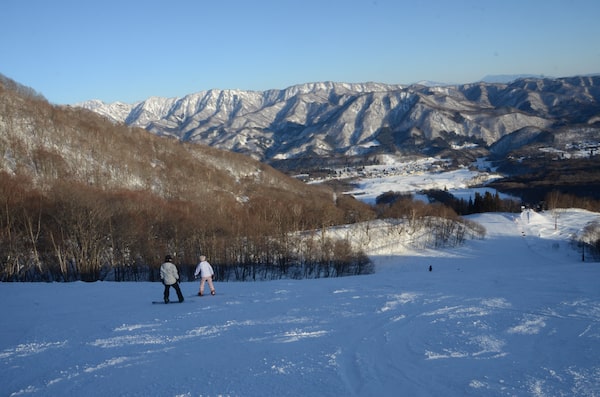
Andrew Findlay and his family explored the Japanese Alps of Honshu.Andrew Findlay/The Globe and Mail
It’s snowing so hard on Suginohara Ski Resort that even the kamoshika, an endemic goat-like deer we spotted traversing the lift line the last ride up, seems stunned. In the time it takes to ride the chairlift, our tracks are covered. By midafternoon, the small crowd of skiers and boarders has dispersed. For one last run, I chase my 11-year-old and 13-year-old daughters down the prosaically named Super Giant Trail, both of them sending out contrails as they straight-line through thigh-deep fluff.
My wife and I had spent six weeks working and travelling in Southeast Asia with the kids. Being a skiing family, the icing on the cake was a two-week road trip in Japan. Not the bucket-list powder skiing destination of Hokkaido – that northern island has gotten plenty of ink over the years. I wanted to explore the Japanese Alps of Honshu, a mere four-hour drive from the world’s most populous city, Tokyo, and the mountains where skiing got its start in Japan a century ago.
Club Med’s fourth ski resort on Hokkaido fuels a ski day with fun and good food
“Obscene amounts of snow” was the colourful forecast provided by Matt Dunn, the Scottish expat owner of two lodges, Morino Hakuba and Morino Myoko, before our family departed Hakuba Valley two days earlier in our camper van.
After three days of skiing groomed runs and moguls in Hakuba, we were ready for this tasty weather forecast. We were bound for Myoko Kogen, a 100-kilometre drive northeast of Hakuba, and a collection of small resorts strung along the shoulder of Mount Myoko, a still-active volcano rumbling quietly in the clouds.
Dunn called Myoko the “Wild West.” I was intrigued.
Winter in Japan has a magical quality. Snow often falls in copious – in other words, “obscene” – amounts. Frigid Siberian air sweeps across the continent, scooping moisture from the Sea of Japan before depositing up to 15 metres of snow annually here in the Japanese Alps of Honshu, the largest island in the archipelago. Geothermal water gurgles from the earth and is channelled into onsens, traditional hot-spring bathing facilities, then discharged onto steep streets as a form of snow removal. Ancient Shinto shrines, insulated in snow, take on another level of beauty and serenity.
Lunchtime ramen.Andrew Findlay/The Globe and Mail
Then there’s the quirk and charm of traditional family-owned restaurants serving ramen, savoury pancakes known as okonomiyaki or some other Japanese delicacy that make après eating into a culinary adventure. After a month and a half of Vietnamese pho and Thai curries, our normally fussy young eaters were in experimental moods, willing to stretch their taste buds. However, they drew the line at sakuraniku, thinly sliced raw horse meat that to me is delicious.
But back to snow. En route to Myoko, we stopped in Togakushi, a village renowned for skiing, Shinto shrines and a centuries-old tradition of soba noodle-making in the mountains above Nagano, host city of the 1998 Winter Olympics. Powder skiing seemed like a pipe dream. Snowfall had turned to rain as we bobsledded our camper van into Togakushi Ski Resort’s slushy parking lot.
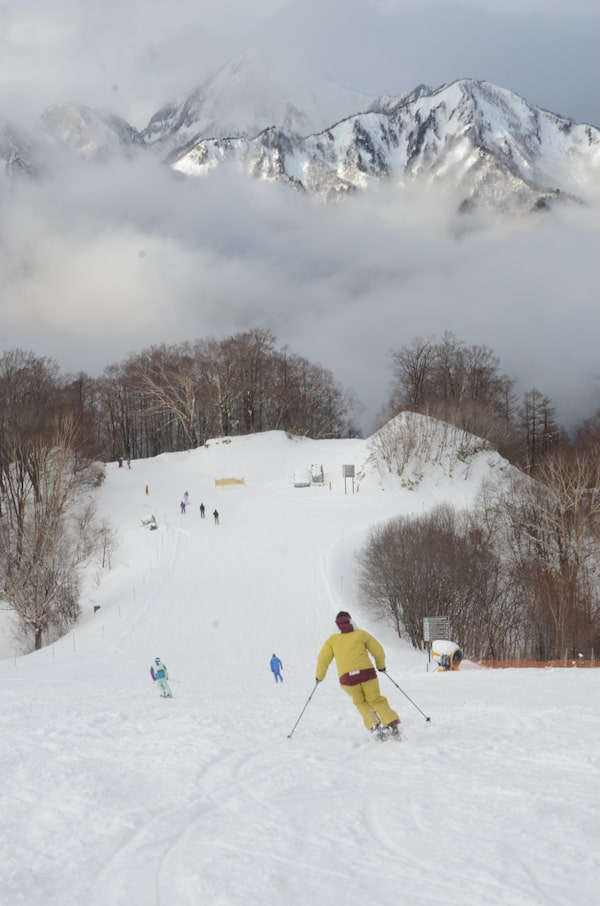
Togakushi Ski Resort.Andrew Findlay/The Globe and Mail
Undeterred, we swooshed around for a few hours on the spring-like slopes of Togakushi. I winked at my beloved when we dropped into an intermediate run called Romantic Course. There was nothing romantic about the conditions. Tired of squeegeeing our goggles, we bailed for an early lunch at Uzuraya, a legendary soba noodle shop.
Soba is made from buckwheat, a grain that grows well in the rich volcanic soil and short growing season below Mount Togakushi.
“My parents taught me the art of soba noodles,” says Tashiyuki Tokukate, a soba chef and restaurateur who, at a spry 73 years of age, skis regularly.
In Japan, devotion to task is impressive. Whether it’s Tokukate making fresh soba noodles every morning for 50 years, or the Togakushi liftees diligently wiping chairlift seats dry before loading skiers, they do it with pride.
The four of us sink chopsticks into warm bowls of soba served in a simple broth of dried kelp, sake, mirin and soy sauce. The side of vegetable tempura vanishes too quickly.
The next morning, temperatures thankfully dropped and the sun poked through a hole in the clouds, as we skirted the edge of Myoko-Togakushi Renzan National Park in our trusty camper van. Along the way, we witnessed a delightful sight – locals gearing up for a looming snowstorm.
True to national character, the Japanese have turned snow removal into a fine art. Elderly men and women arranged snow shovels neatly against their garage doors. Others tinkered with snow blowers, in such a variety of shapes and sizes to make a mockery of the Canadian Tire winter catalogue.
Just in time, we shoehorned our camper van into the parking lot at Morino Lodge Myoko. Flakes drifted lazily at first, sparkling in the streetlights. Like a freight train without brakes, the weather gathered intensity. The next morning a winter wonderland appeared along with a beeping symphony of snow removal equipment at work – the skier’s alarm clock. And the snow continued to fall.
We had arrived. After skiing Suginohara Ski Resort on our first day in Myoko, we spent the next three gorging on powder at nearby Akakura Kanko, Akukura Onsen and Lotte Arai Ski Resorts. I was now feeling confident with Japanese winter culture, and the daily ritual of skiing in a snowstorm, exploring Japanese food and vending machine curiosities like cans of hot coffee, topped with a nightly onsen.
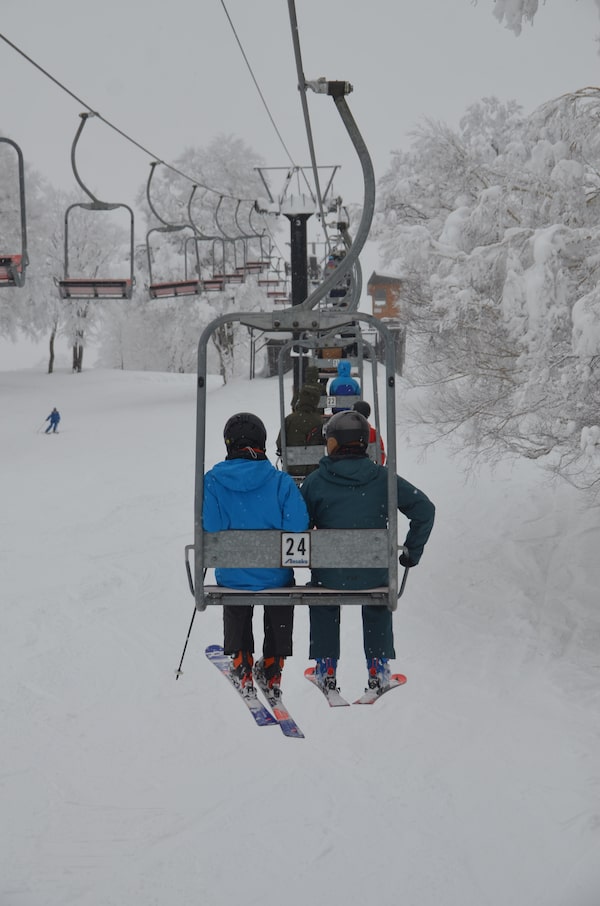
Heading up the misty mountain at Nozawa Onsen Ski Resort.Andrew Findlay/The Globe and Mail
That is, until we visit Nozawa Onsen, a wondrous, eighth-century town of narrow cobblestone streets and more than a dozen free public bathhouses with a reputation for tourist-scorching hot water. With its cafés and pastry shops, Nozawa Onsen has notes of the European Alps, a legacy of Hannes Schneider, the Austrian skiing pioneer seconded by the Japanese government in the 1930s to teach and promote skiing as a national pastime. It worked: Today there are almost 600 ski resorts between the islands of Honshu and Hokkaido.
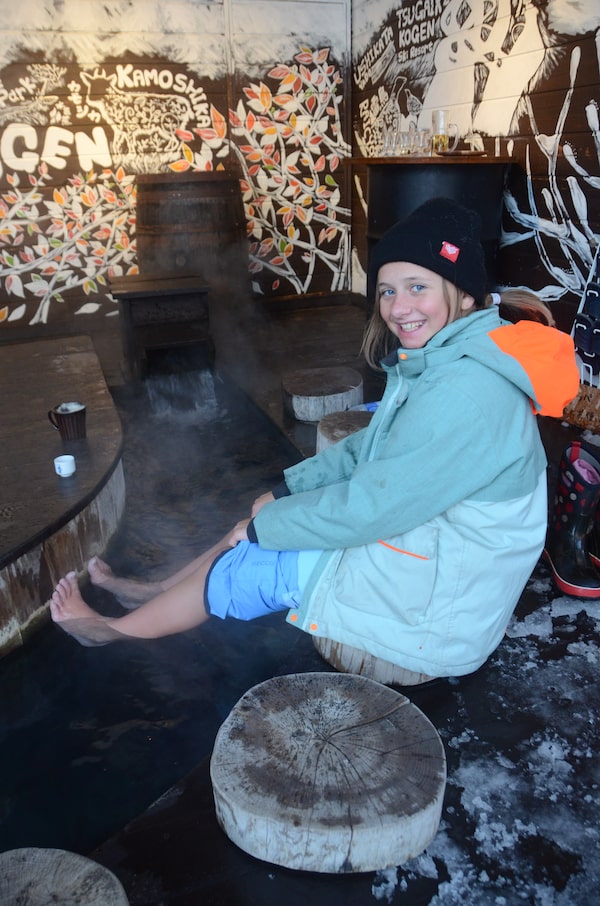
Sabine Findlay enjoys an après-ski foot onsen.Andrew Findlay/The Globe and Mail
Up on the sprawling slopes of Nozawa Onsen Ski Resort, most of the fresh powder is gone. Moguls are forming. We decide to end the day early and head for the village and Kawahara yu Onsen. The smell of sulphur, a mineral that occurs naturally in geothermal water, is strong.
My wife and two daughters disappear through the women’s entrance. I head solo through the men’s.
A sign on the wall reads 45 C: “I got this,” I tell myself. All modesty is checked at the onsen door. I strip and sit on a cold wooden floor and as per custom, lather and shower before getting into the bath. I gingerly dangle my lower limbs into the pool then quickly retract. It feels like Medieval torture. On the other side of the wall, I hear the muffled shrieks of my girls. I fidget poolside, naked, cold and ridiculous, next to a local who sits calmly submerged to his neck.
“You must plunge quickly then stay completely still,” he kindly volunteers.
I summon courage, follow the advice and to my surprise it doesn’t result in a third-degree scalding. Instead, the mineral-rich water wraps me in a sumptuous and rejuvenating embrace.
A good friend of mine likes to say that skiing is just turning left and right on a 30-degree slope. It’s the in-between moments that make travelling for snow so appealing. Otherwise, why leave home? That’s winter in Japan, an amalgamation of wonderful little moments. Throw in some of the most incredible powder snow on the planet, and the fantasy is complete.
If you go
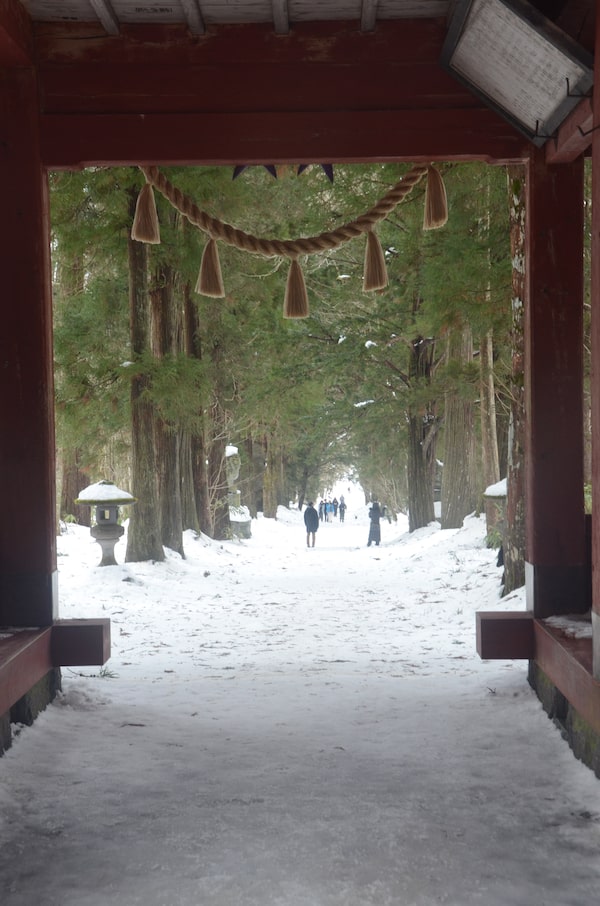
Giant cedars line the path to Okusha Shrine, an ancient Shinto shrine near Togakushi.Andrew Findlay/The Globe and Mail
Japanese ski resorts are a bargain by North American standards, thanks to intense competition. For example, at Suginohara Ski Resort kids under 12 ski for free and an adult day ticket goes for roughly $50. Go to Myoko Tourism to learn more about the resorts, getting around and lift ticket discounts. In Hakuba Valley, the Epic Pass gives riders unlimited access to 10 resorts.
Japan Road Trip rents camper vans in Tokyo equipped with winter tires and chains, as well as comfortable heaters that can make for a cozy winter road trip for two or four. Travellers can park and camp for free at the more than 1,000 Miki no Eki, or roadside stations, across Japan, all featuring heated bathrooms and some with restaurants and convenience stores.
Stay: Morino Lodge offers well-situated accommodations in Hakuba and Myoko. Start the day at Morino Myoko with a hearty North American-style buffet breakfast and finish it in the hotel’s gorgeous outdoor onsen.
One of the joys of a Japanese winter is the food. Ramen and soba shops, sushi and okonomiyaki specialists, or casual izakaya (like a Japanese tapas bar) tend to be small family-run affairs. Many require reservations while at others, expect to wait for a table between the 5 p.m. to 8 p.m. dinner rush.
Resort Etiquette: Terrain management at Japanese ski resorts can be a bit of a puzzle. Approaches vary widely, from resorts like Hakuba Cortina with a relaxed tree skiing and boundary policy, to Togakushi Ski Resort which has a strict off-piste ban. Make sure you understand the do’s and don’ts. When in doubt hire an English-speaking ski instructor to guide you around.
Most signage at ski resorts in Myoko and Hakuba Valley is in English. Off-hill at restaurants and shops, especially in the more traditional Japanese towns of Myoko, a few other Japanese phrases can go a long way in breaking the ice. So too can Google Translate, now widely used by locals and foreigners.
The writer’s trip was partially supported by Hakuba Tourism, Japan Road Trip and Morino Lodge. None read or approved the story before publication.